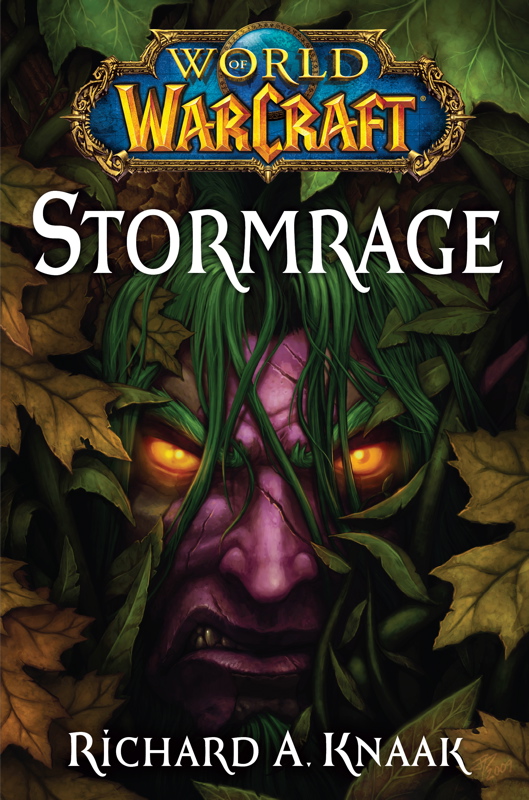Let’s try something new. This will be my first ever book review.
Mild spoilers for Stormrage by Richard A. Knaak below! If you want to approach the book with no preconceptions, avoid reading this blog post.

Stormrage, it must immediately be noted, is a novel that takes place within the game World of Warcraft, and, like the other WoW books I’ve read, successfully expands the narrative outside of the confines of the initial game. In the case of Stormrage, it depicted an event within the narrative which I was not previously aware had even occurred, and thus added to my enjoyment and knowledge of the game world as a whole. As with the other WoW books I’ve read (namely War Crimes, Illidan, and Arthas: Rise of the Lich King, in that order), it has been an enjoyable fantasy novel for me, but not one that I’d consider recommending to somebody who isn’t already acquainted with the Warcraft universe, as there are often many settings, character relationships and events which have been conceived and developed outside of the book series.
Out of the aforementioned Warcraft books I have read, Stormrage is that first I’ve read that has been written by Richard Knaak, the others being written by either Christie Golden, or newcomer to the series William King. Having heard some previous criticism of Richard Knaak’s writing, I entered into my reading with caution, and indeed did find some criticisms which I shall note further on.
Stormrage, then, is a novel which depicts events taking place between the World of Warcraft expansions Wrath of the Lich King and Cataclysm. The Emerald Dream has long been an alternate plane of existence in which the blueprints of a perfect Azeroth could be experienced, with no demonic or otherwise sentient meddlings shaping the world. Maintained by the druids of Azeroth, it has long been a place of paradise and prosperity. However, when an unearthly mist starts causing the citizens of Azeroth to fall into a comatose state, it becomes clear that all is not well, and it soon becomes apparent that Arch-Druid Malfurion has been captured within the Dream, which is rapidly becoming tainted by what is soon to be known as the Emerald Nightmare.
If I had to describe this book in one word, it’d be ‘long-winded’. I’ll immediately emphasise that I did enjoy the book, and I don’t regret reading it, but the malign forces which beseech the characters keep growing in stature, and when reading about setback after setback it might soon occur to the reader that the narrative might be shorter and sweeter should a few of these setbacks fail to occur. I found myself somewhat lost in the geography of the story arc when almost exactly midway through, I began reading what felt like a (hard-fought) climactic struggle. The narrative also suffers from the task of portraying too many abstract concepts, such as the barriers between Azeroth and the Emerald Dream breaking down, and a druid (whom I shall not name) wielding powers of global proportions sometime in the narrative.
One thing this novel does right, though, is provide an excellent platform through which to explore the characters we have already seen in-game, and challenge their deepest fears as they face the onslaught of their worst nightmares. Tyrande, in particular, is noted as fearing her evil predecessor as leader of the night elves, and the corruption which threatened to lead her people into darkness. Stormrage also introduces lesser characters such as Broll Bearmantle, whom I severely hope will make an appearance in an upcoming World of Warcraft expansion. Furthermore, as previously mentioned, Knaak is tasked with portraying some very abstract concepts which I feel many writers would choose to avoid if given the chance, whereas Stormrage, being in the rare position of depicting events of what is typically a visual and interactive world, must make do attempting to describe them; Knaak’s writing, whilst imperfect, never left me clueless as to the events unfolding before me. I do feel the need to make an example of some of his stiff writing, however:
The vision had so troubled her today that Shandris could no longer sit still. Hoping to clear her thoughts, she had personally begun patrolling the length and breadth of the capital, wending her way from the fortified bastion of the Warrior’s Terrace down into the commercial sections of the Tradesmen’s Terrace, on through the mystic Temple of the Moon and across the lush, sculptured islets of the garden. There, she had made a detour to the industrious Craftsmen’s Terrace before returning to her quarters in the Warrior’s.
The only purpose this paragraph serves is to portray Shandris’ uneasy state of mind, and there are much faster ways with which this could have been achieved. Knaak’s description of her patrol through Darnassus was, whilst descriptive, an entirely futile endeavour, and I regret to say that the novel is riddled with similar such passages. The other pet peeve I have is the way Knaak will hint at a character’s discovery, discuss it at length, but fail to inform the actual reader what the character is talking about until at least a few pages later. All this does is make me feel lost and irritated, rather than in suspense, as is likely the intention. Perhaps if the novel was not dealing with such abstract concepts, this style of writing would be more forgivable.
If you are a World of Warcraft fan, though, I recommend this book nonetheless. One of the upcoming raids of the next expansion has players actually fighting in the Emerald Nightmare, so this will be some good background reading, and despite my criticisms of Knaak’s writing, he does the job of providing an entertaining narrative featuring some fan-favourite characters. I must admit that I prefer other works within the series from Christie Golden and William King, but I’ll certainly not shy away from reading other Knaak books.